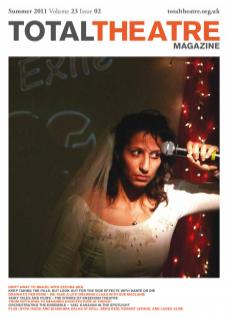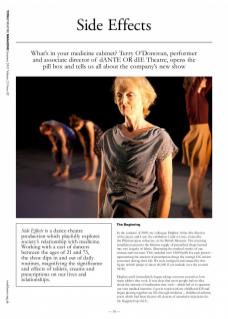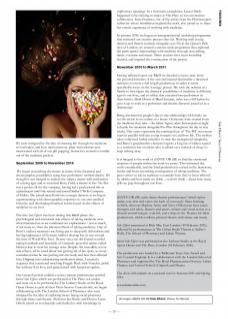Side Effects is a dance-theatre production which playfully explores society’s relationship with medicine. Working with a cast of dancers between the ages of 21 and 73, the show dips in and out of daily routines, magnifying the significance and effects of tablets, creams and prescriptions on our lives and relationships.
The Beginning
In the summer of 2009, my colleague Daphna Attias (the director of the piece) and I saw the exhibition Cradle to Grave, created by the Pharmacopeia collective, at the British Museum. The stunning installation presents the lifetime supply of prescribed drugs knitted into two lengths of fabric, illustrating the medical stories of one woman and one man. This included over 14,000 pills for each person – representing the amount of prescription drugs the average UK citizen consumes during their life. We were intrigued and amazed by this figure (which jumps to about 40,000 if you include over the counter meds).
Daphna and I immediately began asking everyone around us how many tablets they took. It was clear that most people had no idea about the amount of medication they took – which led us to question our own medical histories. I got in touch with my childhood GP and began piecing together my life through medicine – childhood asthma, warts which had been frozen off, dozens of anesthetic injections for my buggered-up teeth...
We were intrigued by the idea of charting life through the medicine we had taken, and how much memory, place and emotion were intertwined with all of our pill popping. Narratives seemed to tumble out of the medicine packets.
September 2009 to November 2010
We began researching the theme in terms of the theatrical and choreographic possibilities using four performers’ medical diaries. We thought it was integral to explore the subject matter with performers of varying ages and so recruited Betsy Field, a dancer in her 70s. She was a perfect fit for the company, having led a professional life as a pharmacist until she retired and joined Sadler’s Wells Company of Elders. She joined myself and two younger dancers as we began experimenting with choreographic responses to our own medical histories, and developing theatrical stories based on the effects of medicine in our lives.
The title Side Effects was born during this R&D phase: the psychological and emotional side effects of taking medicine were what interested us as we continued our explorations – just as much, if not more so, than the physical effects of taking medicine. One of Betsy’s earliest memories was being put to sleep with chloroform and having nightmares of German soldiers chasing her (it was around the time of World War Two). Twenty-one year old Gareth recalled taking hundreds and hundreds of extremely powerful tablets called Minocycline to treat his teenage acne. Despite the incredibly severe side effects, all he cared about was getting rid of his spots, so never considered what he was putting into his body and how that affected him. Dipping into embarrassing medication taken, I created a sequence that connected watching Fraggle Rock with Ventolin, pubic lice with my first love, and paracetamol with hangovers galore.
Our research period yielded a twenty-minute performance entitled Initial Side Effects which was performed at The Place in London and went on to be performed at The Linbury Studio at the Royal Opera House as part of their Firsts Season. Concurrently, we began collaborating with The London School of Pharmacy who were intrigued by the idea of exploring issues facing social pharmacy through dance and theatre. Professor Ian Banks and Doctor Laura Obiols joined us in rehearsals and fuelled us with knowledge in exploratory meetings. In a fortunate coincidence, Laura Obiols happened to be training in dance at The Place so was an intuitive collaborator. Susie Freeman, one of the artists from the Pharmacopeia collective whose installation inspired the work, also joined us to share her artistic experience of working with medicine.
In autumn 2010, we began an intergenerational workshop programme that mirrored our creative process thus far. Working with young dancers and theatre students alongside over 55s in the Queen’s Park area of London, we created a sixteen-week programme that explored the participants’ relationships with medicine through storytelling, dance, costume and music. These sessions have been incredibly fruitful, and inspired the continuation of the project.
November 2010 to March 2011
Having reflected upon our R&D we decided to move away from the personal histories of the cast and instead fictionalise a theatrical narrative to create a full-length production, in order to more specifically focus on the ‘average’ person. We took the nebulas of a family to investigate the dramatic possibilities of medicine at different ages in our lives, and to reflect that recruited two performers in their forties. Mark Down of Blind Summit, (who was a GP before he gave it up to work as a performer and theatre director) joined us as a dramaturge.
Being interested in people’s day-to-day relationships with meds, we set the action in an outline of a house. Characters were created from the medicine they take – the father figure takes Temazepam at night to battle his insomnia alongside Pro Plus throughout the day to stay awake. One scene represents the continued use of ‘The Pill’ over many years in parallel with the young woman’s sex and love life. The mother takes continued herbal remedies to treat her menopausal symptoms, and Betsy’s grandmother character ingests a long list of tablets typical to a woman in her seventies who is reliant on a cocktail of drugs to keep ticking away.
It is integral to the work of dANTE OR dIE to find the emotional response of people within the work we create. This informed the work considerably, and the final production is rooted in the humorous, tender and heart-wrenching consequences of taking medicine. The piece strives to ask its audience to consider how they’ve been affected by tablets and how much we think – or don’t think – about how many pills we pop throughout our lives.
dANTE OR dIE make dance-theatre performances ‘which tiptoe under your skin and caress the back of your neck’. Since forming in 2004, directors Daphna Attias and Terry O’Donovan have taken trumpets and tubas, dancers and actors, writers and visual artists to a disused aircraft hanger, a ski-lift, and a ship on the Thames for their productions, which combine physical theatre with dance and music.
Side Effects premiered at Rich Mix, East London (10 February 2011), followed by performances at The Lillian Baylis Theatre at Sadler’s Wells, The School of Pharmacy and Laban Theatre.
Initial Side Effects was performed at the Linbury Studio at the Royal Opera House and The Place, London (18 February 2010).
The production was funded by a Wellcome Trust Arts Award and Arts Council England. It is a collaboration with the London School of Pharmacy and supported by The Royal Pharmaceutical Society, Laban Theatre, and Central School of Speech and Drama.
The show will embark on a national tour in Autumn 2011 and Spring 2012.


